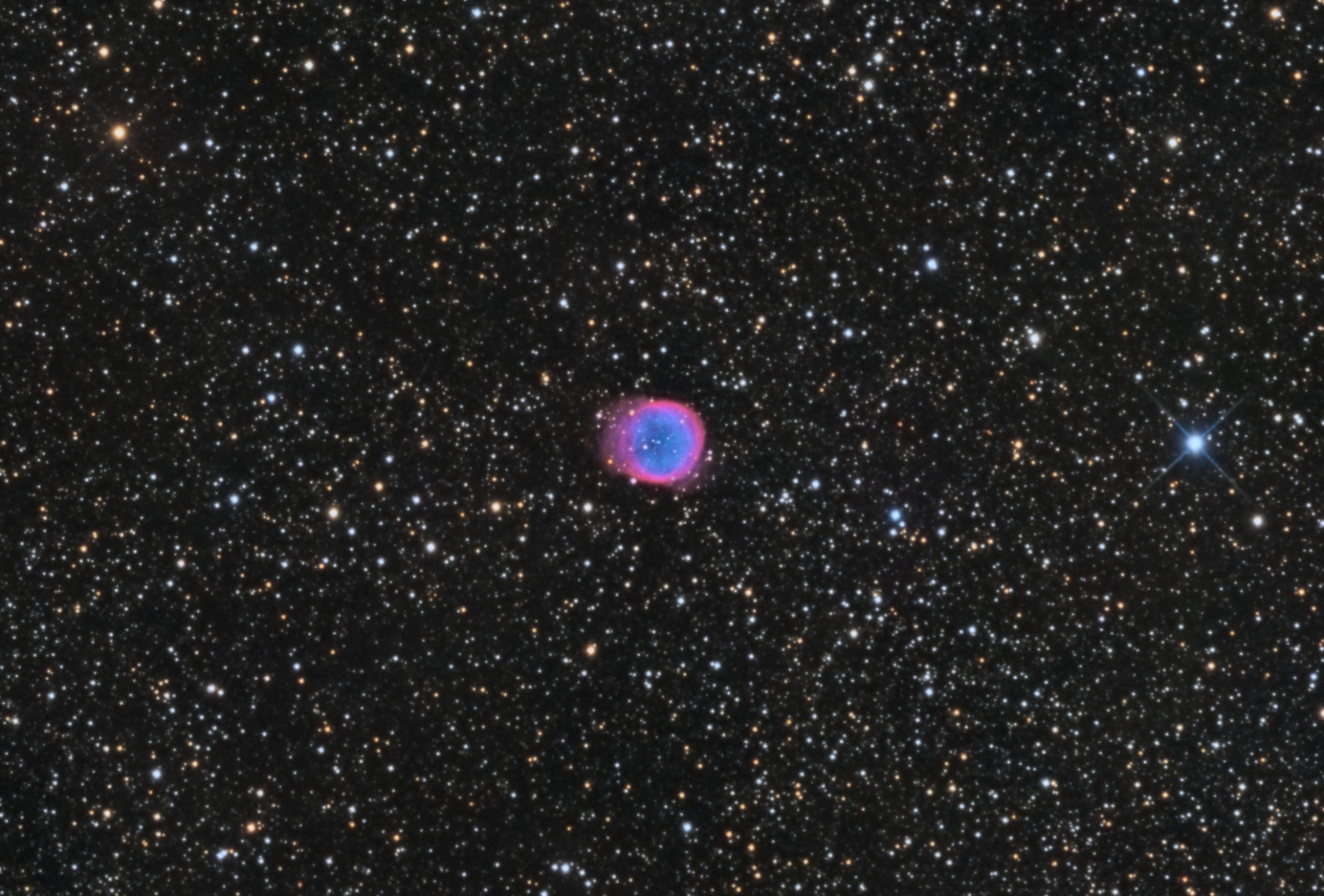NGC6781 Planetary Nebula
 Click image for full size version
Click image for full size version
July 1, 2016; Astronomy Magazine, November 2016
NGC6781 is a planetary nebula in Aquila. Its vivid colours come from hydrogen (red/pink) and oxygen (blue/teal), gases thrown off by the dying star at centre. Like many planetary nebulae, it is a relatively small object, with a diameter less than 1/15th of the Moon’s. In spite of many images of this object out there, I could find relatively little technical information about this object. The name “planetary nebula” doesn’t mean this object has anything to do with planets. But when observers first saw these objects they had a disc-shaped, planet-like appearance, and the name stuck.
Tekkies:
SBIG STL-11000M camera, Baader Ha, R, G and B filters, 10″ f/6.8 ASA astrograph, Paramount MX. Guided with QHY5 guider and 80 mm f/6 Stellar-Vue refractor. Acquisition and guiding with TheSkyX. Focusing with FocusMax. Automation with CCDCommander. All preprocessing and processing in PixInsight. Shot from my SkyShed in Guelph, Ontario. Nearly full Moon for Ha and no moon for RGB. Good to very good transparency and seeing throughout acquisition.
29x20m Ha, 12x15m R, 12x15mG and 12x15mB unbinned frames (total=18hr40m).
Initial Processing:
Ha, R, G and B masters were cropped and processed separately with DBE.
RGB
R, G and B were combined to make an RGB image which was processed with DBE and ColorCalibration. MultiscaleLinearTransform was used to reduce noise in the background areas. HistogramTransformation was applied to make a pleasing yet bright image.
Synthetic Luminance:
Creation and cleanup: The cleaned up Ha, R,G and B masters were combined using the ImageIntegration tool (average, additive with scaling, noise evaluation, iterative K-sigma / biweight midvariance, no pixel rejection).
Deconvolution: A copy of the image was stretched to use as a deconvolution mask. A star mask was made from unstretched L to use as a local deringing support image. Deconvolution was applied (125 iterations, regularized Richardson-Lucy, external PSF made using DynamicPSF tool with about 20 stars; local deringing at 70% and global dark deringing at 0.02).
Linear Noise Reduction: MultiscaleLinearTransform was applied to reduce the noise.
Stretching: HistogramTransformation was applied to make a pleasing yet bright image. TGVDenoise was applied and the image was stretched again to reset the black point.
Combining SynthL with HaRGB:
The luminance channel of the HaRGB image was extracted, processed and then added back into the HaRGB image as follows:
1. Equalize RGB channels with RGBWorkingSpace and extract luminance from the HaRGB image.
2. Apply LinearFit using SynthL as the reference.
3. Use ChannelCombination in Lab mode to replace the HaRGB’s luminance with the fitted luminance from step 2.
4. LRGBCombine was then used to make a SynthLHaRGB image.
Final Processing
HistogramTransformation was used to reset the black point and grey point. Then a range mask was produced that allowed used to slightly increase the brightness of the nebula. HDRMultiscale Transform was applied at a scale of 6 pixels in median mode, and LocalHistogramEqualization was applied in two passes at scales of 50 and 150 using a mask to protect background and stars. Then overall contrast was increased and saturation and brightness increased slightly with the Curves tool.
UnsharpMask was applied to the brightest parts of the nebula and bright stars. A final tweak of brightness and saturation was applied with Curves.
Image scale is about 1.1 arcsec per pixel for this camera / telescope combination.







Leave A Comment